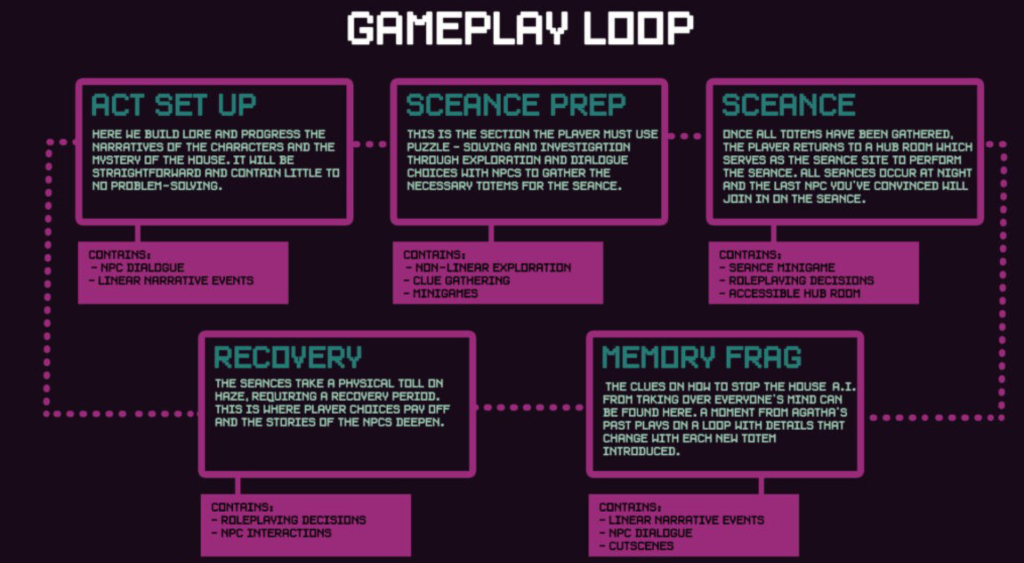For Week 6 we studied gameplay and game systems.
What makes a good game loop?
- Mechanics that give the player the chance to develop their skills
- The loop can be used as an alternative to just creating more content, without players feeling like the game is being stretched thin
- Provides a consistant unifying experience so players understand new areas of the game
When creating a game loop, I must ask what the player’s goal is at the moment, and what feedback will help them towards that goal. This will create progression, a feeling that will help engage the player.
Progression Ideas:
- Players start at the very bottom with no skills, items, or abilities.
- Skills are presented, but denied player access, and must be unlocked by gating mechanisms such as experience or money
- Players are given several skills at the beginning that they must learn how to use
A game loop is a system, which is an interconnected set of elements that is organised in a way that achieves something. Eg; cause and effect; choice and consequence.

What does the player do in my game?
The first half is spent ascending the underground tower, looking to escape. The second half is spent watching the cameras, preventing anyone from coming close to you.
What is my proposed gameplay?
The first half will be spent sneaking down corridors, finding hiding spots, and avoiding cameras. The second half is spent using the cameras and your previous knowledge of its blind spots to shuffle the corridors and prevent people from coming near you.
PITCH:
In addition to this, we were given a deadline for Week 8, which will be used for critical feedback. We must create and present a concept pitch with 3 slides of minimal text, containing:
- A working title, genre, intended target audience, and a short 1 or 2 sentence pitch of the game.
- 3 Game Pillars, each with a 1-2 sentence explainer next to it.
- Core Game Loop, with key actions and resource flow and mock ups with explainers detailing what it roughly looks like.
The deadline will be the 15th of November, so I have one week.
Videogame Movie Club: Silent Hill (2006)
This week, a member of my class launched Video-Game Movie Day. The purpose is to give us a better understanding of the link between movies and games, and open up discussion about them. The transition from game to movie, or vice-versa, is a deceptively difficult one, and with more and more movies being made on existing IPs it’s worth talking about. Some recent examples have been the Five Nights at Freddy’s Movie, the Sonic Movies, and the Mario Movie, as well as the up and coming Minecraft movie.
This week we watched Silent Hill (2006), based on the videogame Silent Hill made in 1999 for the Sony Playstation. It was not a franchise I was very well-versed in, other than knowing it was a horror game. I was very surprised by how much I enjoyed it. The transition between videogame to movie is not often something done well. Yet I found myself becoming very wrapped up in the plot, and the horror scenes were startlingly tense with very good CGI.
To properly compare it as an adaptation, I watched this walkthrough of the original Silent Hill game.
The most obvious difference to me initially was the protagonist, which in the original game was a man. This surprised me, because a lot of the plot at the end of the movie seemed contigent on the protagonist being a woman – when she absorbs the Reaper Child, it disappears into her womb as a metaphor for carrying a baby.
Guest Lecturer: Venezia Georgieva
Our guest lecturer this week was Venezia Georgieva, who works at Sumo Digital making a new AAA game after previous experience at Mojiworks making Snapchat games, and SEGA’s Creative Assembly with her game design for Hyenas.
Game Pillars:
Venezia stressed the importance of Game Pillars, which are the foundational concepts of a game, of which all of its features should circle back to. Smaller projects should have 3-4 pillars, whereas larger ones are more likely to have around 6 – this keeps the team’s focus. Game Pillars are defined very specifically, with a title and 1-2 supporting sentences, and they are adaptive, often changing as the game evolves. Game Pillars are really important to a GDD, and so I must include them.
My 3 Game Pillars:
- Closed and claustrophobic gameworld
- Sparse, indirect information that forces the player to learn by assumption
- Limited action
Game Loops:
Game loops form the flow of players actions in repeating chains, of which there are 2 types: core game loops and meta game loops.
Core Game Loops form the core mechanics of the game – they will be the actions most repeated, that the player will be expected to build skills on the most.
Meta Game Loops focus on long-term progression that encourage the player to keep playing and “level up”, that are not related to the core game loop.
The game loops can be split down further into time segments, like second-to-second (most repeatable set of actions), minute-to-minute (short term goals and abilities), and hour-to-hour (long term goals that give the player complex goals and story elements of permenant progression) loops.
To design a game loop, you have to list the set of core actions the player will perform, and connect them. This should also include the loss/gain of resources the player will aquire during this loop.
My Core Game Loop:
The Watched:
- Core Loop: Navigate the Tower Level -> Avoid the Cameras -> Reach the next Tower Level -> Repeat
- Meta Loop: Complete Levels -> Develop new hiding/disguising techniques -> Replace the Watcher
The Watcher:
- Core Loop: Watch the Cameras -> Spot Attackers -> Reroute Attackers
- Meta Loop: Prevent Enemies from Encircling you -> Remove the Headset -> Escape the Facility
Meta Game Systems:
The Meta-Game are systems that wrap around the core gameplay to directly affect it, which will keep players engaging in long term goals and ensure they are constantly progressing. It also allows the players to optimise the game with strategy and systemic decisions, giving a level of depth to the game. Meta systems are usually heavily documented, to determine any flaws in the system. This documentation can be done with a few brief sentences, a user story (eg; “as the player, I want x so that I can y”), outlining in detail how it works potential edge cases, diagrams, short paragraphs, and bullet points, and tables to track variables and in-game statistics to help balance the game.
My Meta Game:
As for PARANOIA, there aren’t any additional variables or statistics to track, nor is there combat. The meta-game would entirely revolve around the cameras. Eg; where they are placed, how to find their blind spots, and how to disable them.

Leave a Reply